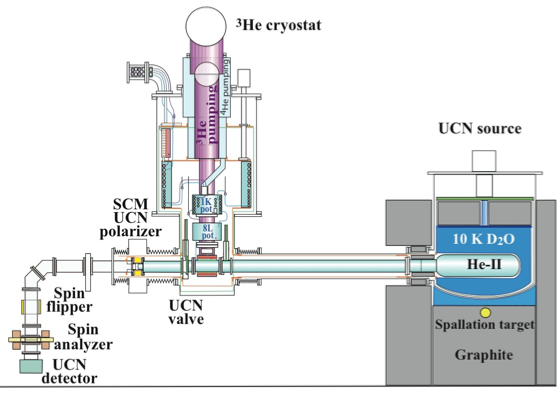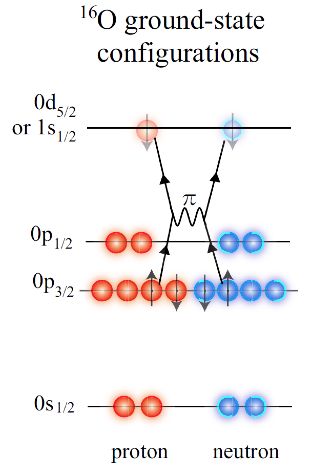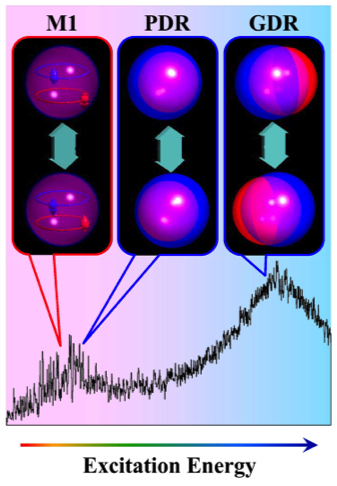Recent Results
Evidence of Tensor Interactions in 16O
|
The tensor interactions are some of the most important nuclear interactions acting between a neutron and a proton in an atomic nucleus. Despite the importance, experiment evidences are scarce and limited to nuclei with masses equal to or lighter than the alpha particle. In a recent experiment measuring the one-neutron transfer (p,d) reaction at large momentum transfer on an 16O target using the RCNP Grand Raiden spectrometer, we observed a possible evidence on the effect of the tensor interactions in the 16O nucleus [1]. The (p,d) cross sections populating the 5/2+ and/or 1/2+ excited state in 15O were found to be increased compared to the cross sections populating the ground 1/2- state with increased momentum transfer. Because (i) the tensor interactions can generate proton-neutron pairs with large relative momentum, and (ii) the population of the 5/2+ and/or 1/2+ excited state via the direct (p,d) reaction is only possible if the ground-state of 16O has mixed configurations which may be attributed to the tensor interactions (see Fig.), the observation of large components of high-momentum neutrons in the ground-state of 16O indicates possible evidence on the tensor interactions. Referrence [1] H. J. Ong, I. Tanihata, A. Tamii et al., Phys. Lett. B725, 277 (2013). |
Fig.: Possible two-particle two-hole configuration in the ground state of 16O due to the tensor interactions. |
EN Course
|
The newly constructed third focal plane (F3) of the EN course was successfully commissioned using secondary beams produced via projectile fragmentation reactions of a 53A MeV 36Ar beam on a 9Be target. Equipped with two Parallel-Plate Avalanche Counters (PPACs) as the position sensitive detectors, and a silicon detector as the DE detector, the extended beam line will be used for experiments with radio-isotope beams from the 2014 fiscal year. Referrence [2] Y. L. Sun, J. Lee, A. Obertelli et al., RCNP Ann. Rep. 2013
|
Ultra Cold Neutron
 The energies of ultracold neutrons (UCN) are lower than the nuclear potential of material, which is referred to as Fermi potential, therefore, UCN can be confined in a material bottle. This property is useful for fundamental physics experiments like a precise measurement of neutron electric dipole moment (EDM). UCN density in the bottle is crucial for the experiment. KEK-RCNP-Osaka group has constructed the second generation UCN source shown in Fig. 2 based on the first generation UCN source [3], which realized a world competitive UCN density. A superfluid helium (He-II) bottle is placed in the horizontal direction. UCN are extracted through an aluminum window, which is placed in a superconducting magnet (SCM). The magnetic potential for the neutron is much higher than the Fermi potential of aluminum so that UCN transmission through the window is enhanced. UCN are polarized upon the transmission. The group has produced fast neutrons by spallation reactions induced by 400 MeV protons on a tungsten target, moderated these neutrons to cold neutrons in the 300K and 10K heavy water (D2O), and converted to UCN in He-II. The UCN valve was opened after UCN production. UCN were guided to the UCN detector through the spin flipper and analyzer. A significant number of UCN was observed. UCN polarization was higher than 70%. The UCN density is proportional to the proton beam power. We have carried out a cooling test for the cryostat, and confirmed the cryostat can remove γ heating at higher proton beam powers. The present cryostat will produce 10 times higher UCN density than the first generation UCN source. Referrence [1] [3] Y. Masuda, K Hatanaka, S.C. Jeong, S. Kawasaki, R. Matsumiya, K. Matsuta, M. Mihara, and Y. Watanabe: Phys. Rev. Lett. 108, 134801 (2012).
|
Pygmy Dipole Resonance:
|
Concentration of electric dipole (E1) strength in the vicinity of the neutron threshold has recently been found in several stable and unstable heavy nuclei. The strength is called the low-energy dipole strength or the Pygmy Dipole Resonance (PDR) in relation to the theoretical predictions of the dipole oscillation of the neutron skin against the isospin-saturated core. The PDR strength has been studied by applying the proton inelastic scattering at forward angles employing the high-resolution spectrometer Grand Raiden. The PDR strength in 90Zr has been clearly separated from the spin-M1 contribution (Fig. ) [1]. Concentration of the skin-oscillation type transition density is also found in 208Pb [2]. Referrence [1] C. Iwamoto et al., PRL 108, 262501 (2012). |
Fig.:Observation and separation of PDR and spin-M1 contributions in the lower excitation energy bump in 90Zr [1]. |
Gamow-Teller Strength and the double-beta decay matrix element
|
The Gamow-Teller strength distribution has been determined by (3He,t) charge-exchange rations on 136Xe [3], 71Ge [4], 76Ge [5], 128,130Te [6], 100Mo [7] and 96Zr [8]. The data are important to study the double-beta decay nuclear matrix-elements as well as the charged-current reaction cross sections of neutrino detectors. Referrence [3] P. Puppe et al., PRC 84, 051305(R) (2011).
|
MuSIC
|
Muon yields at the end of the 36 degrees solenoid channel were measured. The yields (~108muons/sec/μA) show good agreement with the simulated results. Then the system was successfully operated with a higher power (1μA) proton beam. From these results, we confirmed that the MuSIC works as designed. The feasibility study of muon capture isotope detection has been performed experimentally by using capture reactions on Mo isotopes at MuSIC [10]. Referrence [10] H.Ejiri et al, Journal of the Physical Society of Japan 82 (2013) 044202.
|
Nuclear chemistry and Nuclear medicine
|
Recently, positron emission tomography (PET) has been remarkably developed for visualizing the distribution of a radionuclide in the human and animal’s body. Now the PET is widely used for the diagnosis of cancer. Clinical application of the PET has been made possible with the development of ingenious techniques for rapid synthesis of radiopharmaceuticals, suitable for in vivo studies, using cyclotron within a medical complex. We produced many positron-emitting radioisotopes for nuclear medicine and other radioisotopes for nuclear chemistry by using the AVF cyclotron. The schematic flow of the preparation of the labeled compound used for PET is shown as follows. The 62Zn and 124I were produced by the 63Cu(p,2n)62Zn and 124Te(p,n)124I reactions for PET, furtherαemitter 211At by the 209Bi(α,2n)211At reaction was examined for radiation therapy.
Fig.: Schematic flow diagram of the preparation of the labeled compound for PET.
|





